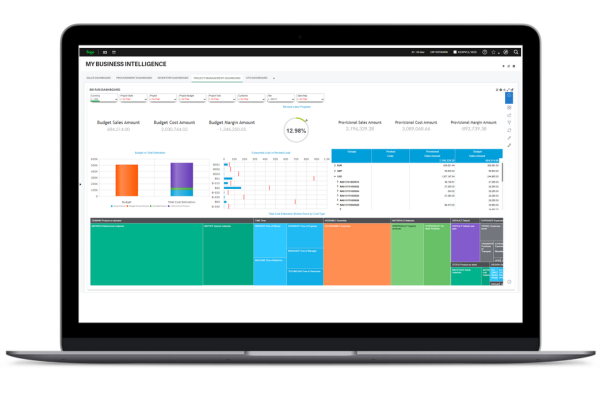How to: Enter or update a Company Address in Sage 200
This tutorial aims to assist users with how to Enter or update a company address in Sage 200.
The way in which organisations buy and deploy software has changed fundamentally over the past decade. From corporate quality, commodity cloud-based software solutions such as Microsoft Office 365 to consumer style mobile apps that provide staff with anytime, anywhere access to key information, the focus is on minimising IT requirements and maximising corporate value.
Is this model extendable across all corporate applications? Is it really possible to commoditise essential business systems such as ERP or CRM – especially when the vast majority of organisations have any number of dedicated third party solutions for warehouse management or specific manufacturing needs that have to be integrated to the core platform?
James Bedford, Director of Infrastructure Services, at The Waterdale Group, outlines the importance of understanding the different deployment options when investing in a new ERP solution.
For any organisation now looking to replace ERP, the decision-making process has changed significantly since the last implementation. Today’s market looks very different – not least the substantial growth in cloud-based software and the innovative mobile solutions now available that can be deployed in minutes.
A hosted approach is certainly compelling on many levels. It offers organisations the chance to minimise IT resource requirements; embrace a controlled, Opex, per user financing model; and enables the IT team to move away from dealing with tedious infrastructure problems to focus on exploiting software to drive business benefit. Critically, it offers rapid deployment – enabling organisations to step away from the extended on premise implementation projects.
However, not all cloud applications are the same – and there is a very significant difference in functionality and agility between commodity, one size fits all – or multi-tenanted – cloud applications, and a dedicated single tenanted model. Furthermore, the decision to implement one of these applications – such as Office 365 – has implications on the rest of the IT infrastructure, not least on options for integration with ERP and CRM solutions that can drive additional productivity improvements.
Given the continued extension in the ERP replacement cycle, with many organisations now planning to retain a new ERP solution for upwards of a decade, the decisions taken today will have to support the business through what will inevitably be a period of further significant change.
So the decision is not just which ERP solution will support the business needs today and deliver the future proofing required to ensure business agility; but what is the best way of deploying that ERP solution. Should it remain on premise? Is a hosted model viable? And how does it work if the business has several key operational systems all deployed in the cloud?
One of the key requirements for any organisation moving to a new ERP system is to improve business agility. Given the sophistication of today’s mature ERP solutions, the core functionality is now a given. What organisations need is the ability to rapidly exploit areas such as business intelligence to support new efficiency initiatives or expansion into new market areas. This, of course, is where the traditional on premise deployment can be a constraint: in a fast moving competitive environment it is often difficult to accurately predict the scope of the ERP requirements from day one.
What happens nine months into the deployment when the business suddenly demands a refocus on warehouse management or tighter integration with the ecommerce platform? It can be hard to support these business changes during the deployment without impacting both roll-out and resourcing.
In contrast, the right hosted model enables that additional functionality to be switched on immediately, for a small incremental per user cost, creating a far more flexible and agile business.
But what is the right model?
While a small but growing number of vendors have launched one-size-fits-all, multi-tenanted ERP solutions, they still have limited appeal to established businesses. The vast majority of organisations need a least some degree of customisation and integration – from meeting business specific warehouse management requirements to linking with a third party manufacturing application – that are simply not an option on these commodity platforms.
And while there is no doubt that the technology will continue to become more sophisticated, businesses actually need the ability to integrate and to customise. Organisations that want to exploit the benefits of hosting without the compromise of commodity need to consider whether a single tenanted ERP deployment that can be integrated with the rest of the infrastructure within a single hosted platform offers a more complete solution.
While many organisations can immediately understand the limitations of a commodity ERP solution, the multi-tenanted options for standard applications such as email and Office appear far more compelling. Why invest in on premise equipment and resources when the cloud based solution is quick and simple to turn on and off – and there are clearly no requirements for customisation in these standard solutions?
However, putting one part of the IT infrastructure in the cloud without considering the overall impact can be a mistake. What happens when the company wants to upgrade the ERP and CRM and exploit opportunities to tightly integrate with email to drive productivity benefits and continue the evolution towards a cloud based IT infrastructure? The options are less compelling – the only way to attain a single, integrated hosted ERP and email model is to buy another Office license and have that integrated with the ERP solution.
Otherwise the company ends up with a hybrid hosted model, with none of the benefits of integration; or, more radically, a step back from the hosted approach and opts again for an on premise ERP deployment. The result? An apparently simple decision to adopt commodity software I the cloud has compromised the business’ overall IT strategy and hence agility and potential return on investment.
The infrastructure decision a business makes today is not set in stone. One size fits all, commodity ERP aside, it is feasible to move from an on premise deployment to a hosted model, even to move between hosted models. But it creates upheaval and adds cost. Critically, it is a distraction from the core objective of exploiting the ERP system for business value.
And this is the key – business agility has fast become a priority for the vast majority of organisations. Whether moving into new geographies or embarking upon radical restructure, such as relocating manufacturing overseas, the ability to make fast, effective changes is critical. So whatever the ERP product decision, it is essential to make sure the business dedicates as much time to considering the underlying infrastructure.
It is only once armed with this understanding that a business should take the next step and determine just which product and how it should to be deployed to best support the business for the next decade.
Keep up to date with CPiO's latest blogs, news and events

This tutorial aims to assist users with how to Enter or update a company address in Sage 200.

Implementing an enterprise resource planning system (ERP) will help you reduce your costs and make your business run smoother but it can be a costly...

1 min read
What is TLS? TLS, or Transport Layer Security is a cryptographic protocol designed to provide communications security over a computer network....